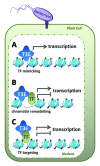Bacterial effectors target the plant cell nucleus to subvert host transcription
- PMID: 22353865
- PMCID: PMC3405691
- DOI: 10.4161/psb.18885
Bacterial effectors target the plant cell nucleus to subvert host transcription
Abstract
In order to promote virulence, Gram-negative bacteria have evolved the ability to inject so-called type III effector proteins into host cells. The plant cell nucleus appears to be a subcellular compartment repeatedly targeted by bacterial effectors. In agreement with this observation, mounting evidence suggests that manipulation of host transcription is a major strategy developed by bacteria to counteract plant defense responses. It has been suggested that bacterial effectors may adopt at least three alternative, although not mutually exclusive, strategies to subvert host transcription. T3Es may (1) act as transcription factors that directly activate transcription in host cells, (2) affect histone packing and chromatin configuration, and/or (3) target host transcription factor activity. Here, we provide an overview on how all these strategies may lead to host transcriptional re-programming and, as a result, to improved bacterial multiplication inside plant cells.
Figures

References
Publication types
MeSH terms
Substances
LinkOut - more resources
Full Text Sources
